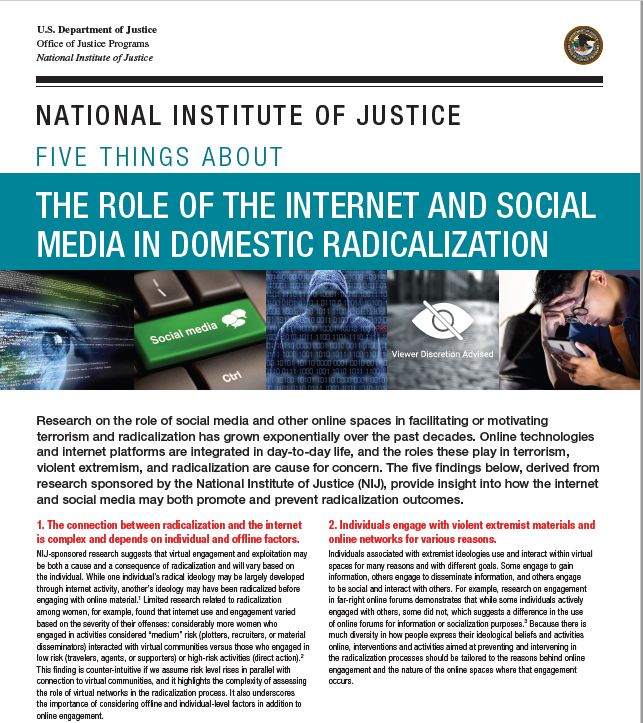Research on the role of social media and other online spaces in facilitating or motivating terrorism and radicalization has grown exponentially over the past decades. Online technologies and internet platforms are integrated in day-to-day life, and the roles these play in terrorism, violent extremism, and radicalization are cause for concern. The five findings below, derived from research sponsored by the National Institute of Justice (NIJ), provide insight into how the internet and social media may both promote and prevent radicalization outcomes.
1. The connection between radicalization and the internet is complex and depends on individual and offline factors.
NIJ-sponsored research suggests that virtual engagement and exploitation may be both a cause and a consequence of radicalization and will vary based on the individual. While one individual’s radical ideology may be largely developed through internet activity, another’s ideology may have been radicalized before engaging with online material.[1] Limited research related to radicalization among women, for example, found that internet use and engagement varied based on the severity of their offenses: considerably more women who engaged in activities considered “medium” risk (plotters, recruiters, or material disseminators) interacted with virtual communities versus those who engaged in low risk (travelers, agents, or supporters) or high-risk activities (direct action).[2] This finding is counter-intuitive if we assume risk level rises in parallel with connection to virtual communities, and it highlights the complexity of assessing the role of virtual networks in the radicalization process. It also underscores the importance of considering offline and individual-level factors in addition to online engagement.
2. Individuals engage with violent extremist materials and online networks for various reasons.
Individuals associated with extremist ideologies use and interact within virtual spaces for many reasons and with different goals. Some engage to gain information, others engage to disseminate information, and others engage to be social and interact with others. For example, research on engagement in far-right online forums demonstrates that while some individuals actively engaged with others, some did not, which suggests a difference in the use of online forums for information or socialization purposes.[3] Because there is much diversity in how people express their ideological beliefs and activities online, interventions and activities aimed at preventing and intervening in the radicalization processes should be tailored to the reasons behind online engagement and the nature of the online spaces where that engagement occurs.
3. Spending more time online and on specific platforms may increase an individual’s risk of engaging with hateful content.
Research shows that individuals (especially youths) who spend more time online and use certain websites (e.g., YouTube) may face an increased likelihood of being exposed to or engaging with hateful or potentially radicalizing content.[4] Other NIJ-sponsored research suggests that the use of specific social media platforms by individuals convicted of ideological crimes varies based on ideology but otherwise mirrors the general population’s use of social media platforms more broadly.[5] Research also finds that associating with others who share similar extremist beliefs online contributes to more radical beliefs over time.[6]
4. An individual’s online interactions with others may increase their risk of exposure to hateful or potentially radicalizing content.
Online interaction with both friends and strangers increases the risk of exposure to hateful content. Research on youths finds that online interaction with close friends was associated with an individual being more likely to see hate content.[7] Moreover, research focused on specific youth populations finds that the odds of viewing racist content online are higher among youths who interact with strangers than those who do not.[8]
In addition, research on a women-only Ku Klux Klan forum suggests that online communities that implicitly promote violence and racism may use coded language. Coded language in this context refers to the use of neutral terms to negatively describe identity (e.g., Blue Pill is used in some extremist online forums as a derogatory term for people with conventional views that are considered “ignorant.”)
In this way, online communities lure in non-extremist individuals and then facilitate their recruitment and radicalization into extremist ideology.[9] Future research should examine how violent extremists exploit specific social media platforms to engage and communicate with new followers or tailor their online propaganda and information dissemination strategies to target specific online communities and users.
5. An individual’s beliefs, characteristics, and behaviors may increase their risk of exposure to hateful or potentially radicalizing content.
Certain individual factors — race, political views, and awareness of what constitutes hateful content and risky internet behaviors — may affect the extent to which individuals (and youths in particular) recognize the potential harm in the content they consume online and their reaction to and level of engagement with it.[10] In addition to broader, federal-level efforts to promote digital literacy and resilience,[11] developing appropriately nuanced educational and preventive strategies are of the utmost importance. Targeted counter-narrative campaigns that debunk misinformation and appeal to different groups’ emotions or grievances is a good first step. These should include targeting specific platforms (e.g., Facebook for far-right extremist forums),[12] disrupting “echo chambers” to challenge old/recycled beliefs (e.g., anti-Black sentiments),[13] increasing the frequency of targeted campaigns after an act of violence,[14] and tailoring campaigns by demographic characteristics (e.g., race, gender, geographic region, and population density).[15]
Learn more:
Radicalization on the Internet: Virtual Extremism in the U.S. from 2012-2017
Opinions or points of view expressed in this document represent a consensus of the authors and do not necessarily represent the official position, policies, terminology, or posture of the U.S. Department of Justice on domestic violent extremism. The content is not intended to create, does not create, and may not be relied upon to create any rights, substantive or procedural, enforceable at law by any party in any matter civil or criminal.


